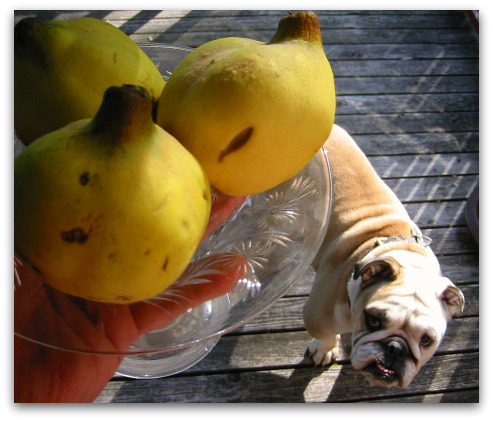Quince: Autumn’s Brightest (and often, most forgotten) Jewel

When we last left our spring quince tree, she was blushing with buds and fruitful possibilities. It seemed Mother Nature had a different plan, one that was rich in rain and parsimonious with the pollinators.
Beautiful Quince Blossoms

And so months later under the full moon of October, the harvest of the quince can be held in two cupped hands.


For the record, Boz prefers the crispy sweet crunch of a Jonagold apple to the dry raw state of an uncooked quince (but it will do in a pinch). Quince is best eatened cooked and usually reserved for jams, jellies, baking and compotes. It’s a fruit that’s better placed in a sauce pan than a snack hand.
My blog pal Sylvie at Laughing Duck Farms shares my love of quince and offers up some great ideas on What to Do With Quinces.
Related links: My Quince Tree in Spring, The Quince’s Delicious History, Cornell:Growing Quince, David Lebovitz: Recipe Quince Tart Tartin, Simply Recipes: Membrillo (quince paste) Recipe.
What I was blogging about a year ago: Violetta Fig Finishes Out the Season (and unfortunately this year, not one fig off the tree).







I am glad to see that I am not the only one who loves quince. Check out my quince ice-cream recipe! (http://www.laughingduckgardens.com/ldblog.php/2009/10/10/what-to-do-with-quinces/).
I had a quince tree in my former garden. I really ought to plant one again. The flowers are indeed lovely.
I’ve seen quince fruit (cotogna) on occasion at the market, but have never tried them in a jam. Will make a point to pick some up to try – yours are so beautiful! And I love Boz!
[…] Update: Here’s what the fruit looked like when harvested in October. […]
[…] delivers on all counts: flowers, fruit and fall foliage, much like another favorite of mine, the fruiting quince. The fruit hangs on the tree like nodding caramels, remaining well after leaf […]
I have the variety Aromatnaya that I planted in 1999. Looks like a good crop this year. When do you think I should harvest?
Kate
I pick mine around the first week of October if the big fall downpours have begun. I dry them off, and use them when ready, usually for quince jam and sometime membrillo.